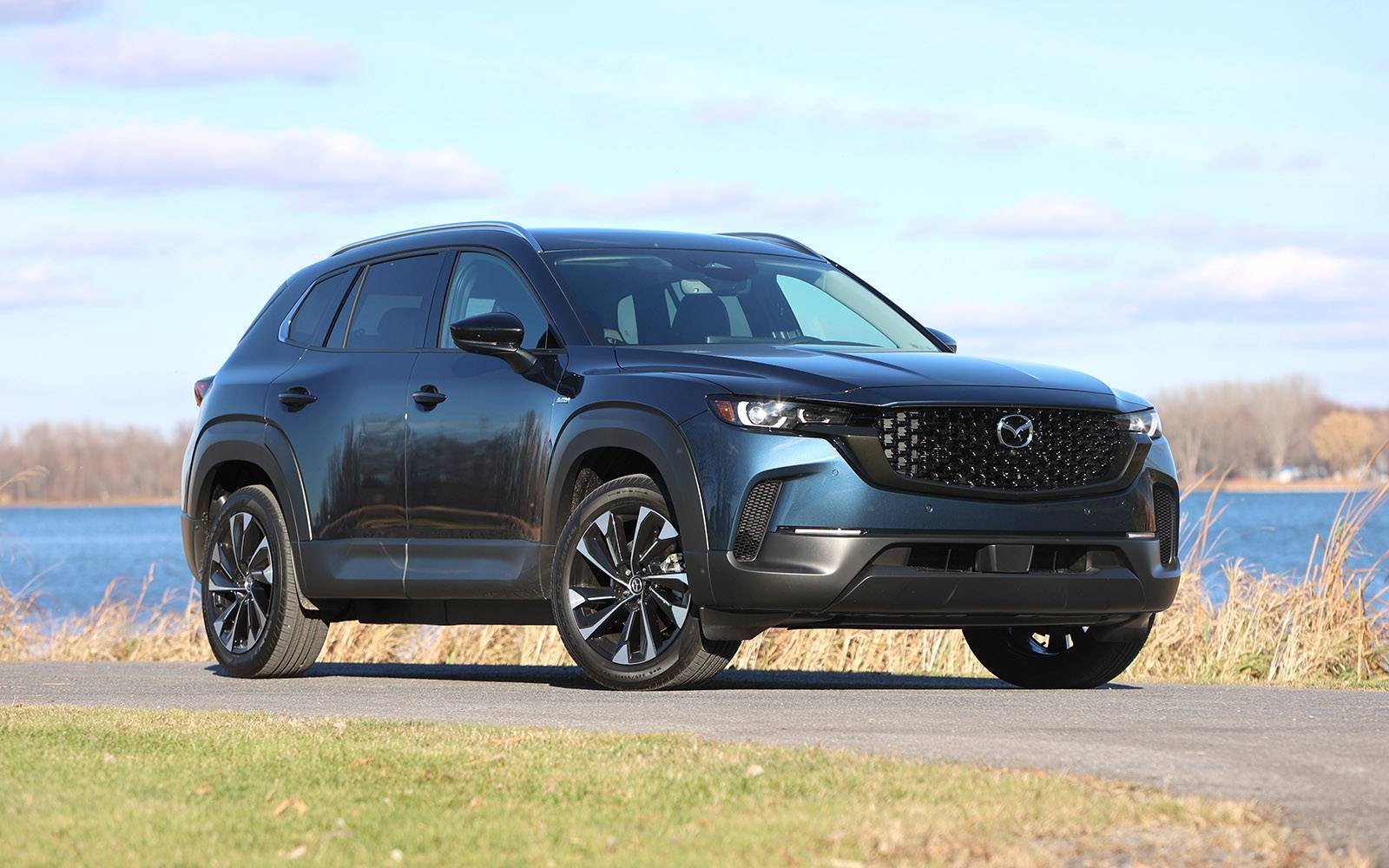2025 Mazda CX-50 Hybrid: More Efficient With Toyota’s Help

| Strong points |
|
|---|---|
| Weak points |
|
The SUV craze has given Mazda the opportunity to introduce several all-new models lately and also create some confusion among customers in the process. The sleek and technologically advanced CX-50 is a compact SUV just like the venerable CX-5 that’s been around since 2013 and has proven to be a strong seller in Canada. Engine selection is the same, too. As a result, the cheaper CX-5 outsold the CX-50 about 5-to-1 last year. Sales of the latter have nearly doubled in the first nine months of 2024, but they’re still far from matching the success of the former.
Other than a slightly roomier interior, why would people buy a CX-50 instead of a CX-5? For one thing, it offers a top-line Meridian model with superior towing and off-road capabilities for adventurous families, although if we had to choose, we’d pick a Subaru Outback Wilderness any day and be glad we did.
- Also: All-New 2025 Mazda CX-50 Hybrid Arrives, Offers Huge Gas Savings
- Also: 2024 Mazda CX-50 Meridian: Go For This One or Stick With the CX-5

Another reason, of course, is the new-for-2025 CX-50 Hybrid, which also has no equivalent in the CX-5 lineup. This will inevitably drive sales and at the same time give the gas-electric variants of the Ford Escape, Honda CR-V, Hyundai Tucson and Toyota RAV4 a run for their money.
Almost a Clone
The Mazda CX-50 Hybrid stands out with a new mid-grade Kuro model that could end up being the most popular in the lineup as it offers better value than the base GS-L, not to mention the higher-end GT priced at over $50,000. Both the GS-L and Kuro ride on 17-inch wheels that make the electrified CX-50 even more fuel-efficient, while the GT gets 19-inch alloys that sure look nicer and improve handling but result in a stiffer ride (blame the lower-profile tires, as well).

There are unique wheels and “Hybrid” badges on the front fenders, but other than that, this vehicle is pretty much identical to non-hybrid CX-50 models. All of them offer a fantastic interior with excellent build quality and premium materials, particularly in GT trim. Mazda has the edge over the entire competition in that department, including the aforementioned Outback (which still doesn’t have a hybrid variant, incidentally).
While a tad more spacious than the CX-5, the CX-50 pales in comparison to the segment leaders. The large transmission tunnel is still there, compromising legroom and comfort for a fifth passenger. As for the trunk, the 1,560 litres of cargo room don’t even come close to the Toyota RAV4 Hybrid’s 1,951 litres.

Speaking of Toyota…
Under the hood of the 2025 Mazda CX-50 Hybrid is a naturally aspirated 2.5-litre four-cylinder engine mated to a pair of electric motors, one of which is mounted over the rear axle, creating an all-wheel-drive setup. Sounds familiar? It should. This is the exact same hybrid system you’ll find in the RAV4 Hybrid. Output is unchanged at 219 horsepower. Not only that, but the CX-50 Hybrid is built in Alabama alongside the Toyota Corolla Cross. Once again, Mazda’s partnership with its much larger Japanese rival pays off.
With the MX-30 not returning for 2025, the only other electrified options in the Mazda lineup are the CX-70 PHEV and CX-90 PHEV. The company had to do something to reduce its corporate fuel consumption average, which is why it decided to add a compact SUV with hybrid technology. And a very efficient one, we must say.

The official ratings show an improvement of 31 percent and 35 percent from the base 2.5-litre engine and the optional turbocharged 2.5-litre engine, respectively. That means you’re looking at annual savings of $1,050 (20,000 km a year, $1.50 for a litre of regular gas). If you compare with the CX-50 Turbo, which prefers premium gasoline (but doesn’t require it), the savings would increase to about $1,700 annually (20,000 km a year, $1.75 for a litre of premium gas).
Of course, the CX-50 Hybrid is more expensive in the first place. How much? Well, it costs $3,000 (plus tax) more than the base CX-50 and $500 (plus tax) more than the CX-50 Turbo. If you drive a lot or plan to keep the vehicle for many years, you’ll easily get a return on your investment.

A Funny Feeling
On the road, the Mazda CX-50 Hybrid sounds very much like a four-cylinder Toyota, especially at low speeds and in full EV mode. But make no mistake: it delivers more dynamic handling than a RAV4 Hybrid. What’s more, we hardly even felt the 80 kg of extra weight. Obviously, it’s not as explosive in a straight line as a CX-50 Turbo, but the instant torque combined with more generous power than the base CX-50 (186 hp) translate into very pleasant acceleration. The AWD system, on the other hand, is a complete departure from Mazda’s own i-Activ system and therefore not as capable. It won’t make any difference for most drivers, though.
To be clear, the new CX-50 Hybrid is the most fun among all the gas-electric compact SUVs out there. On top of that, it’s easy to achieve less than 6 L/100 km in combined city-highway driving, as we found out during a trip from Montreal to Lake Champlain (5.4 L/100 km). Naturally, fuel economy will take a hit in cold temperatures and other elements like the wind, but the same is true with a RAV4 Hybrid or CR-V Hybrid.

Our Verdict
At the end of the day, Mazda customers have a compelling new alternative to turn to with the 2025 CX-50 Hybrid. Hopefully the company will electrify more models in the near future. With the smaller CX-30 and Mazda3 sharing their platform with the CX-50, anything’s possible. As for the CX-5, the next generation will be available with a brand new hybrid system developed in-house, as previously reported.











